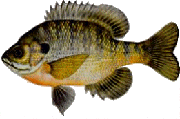

Lepomis macrochirus
 |
HYBRID BLUEGILL |
Lepomis macrochirus |
In recent years the interest in culture of bluegill hybrids has increased greatly. Much of the attention has been focused on the hybrid produced when the male bluegill (Lepomis macrochirus) are crossed with green sunfish (L. Cyanellus). This hybrid has been singled out among the many "bream" species based on its aggressive nature, willingness to accept artificial diets, and skewed sex ratios (greater than or equal to 90 per cent male). This has resulted in in substantial production for stocking into recreational ponds. In Kentucky hybrid bluegill have been evaluated, and show promise, for use in pay lakes (fee fishing). In the north central region of the U.S., hybrid bluegill have also been identified as a species of primary interest for food fish production. Compared to other interspecific hybrids, such as hybrid striped bass, hybrid bluegill are relatively easy to produce. No hormone treatments are required and pond spawning is relatively productive and reliable. One of the most important factors in the production of hybrid bluegill is proper identification of both sexes used in the cross. Improper sexing of even one or two fish can ruin the production of an entire pond. Bluegill males need to be at least two years old and greater than or equal to 1/4 pound in size. Green sunfish females may be much smaller. Broodstock are normally stocked in late winter or early spring at 20-40 pairs per acre. Sex ratios are normally 1:1. Ponds should be filled at least 2-4 weeks before broods are stock. It is essential that no other fish are present in the pond at stocking. The pond should be fertilized to produce a plankton bloom. Providing areas around the edge of the pond with fine gravel, or even gravel in nesting boxes may proved beneficial. Spawning usually occurs at 78-80°F. Fry should be observable soon after hatching. Broodfish may be selectively removed by using a large mesh seine (based on brood size). A powder trout starter diet should be fed around the edges of the pond. Once feeding is observed particle sizes can be increased accordingly. Approximately 100,000 fry per acre may be produced. Fingerlings can reach a stocker size of 2-3 inches in 60-100 days. Transport of 2-3 inch fish is usually less stressful once temperatures cool in the fall. For pond stocking fish are now ready to sell. Wholesale price for 2-3 inches hybrid bluegill is approximately $0.05 each with retail prices of $0.25-$0.40 each. For use in pay lakes, or possibly as a food fish, at least a second year of growth is required. Fingerlings are thinned or stocked in the fall or spring at 5,000-10,000 fish per acre. These fish are fed all they will eat of a floating trout or hybrid striped bass diet of 36-42% protein. Based on research at Kentucky State University approximately 3,000 pounds per acre of fish averaging 1/3 pound each can be produced during this second year. Field trials of this size of fish in pay lakes indicates excellent acceptance by customers and allows the pay lakes to diversify their offerings. One cooperating pay lake operator stated a willingness to pay $2.50 per pound for 1/3 pound hybrid bluegill. Their potential as a food fish has not been well investigated but is being researched in the north central region. |